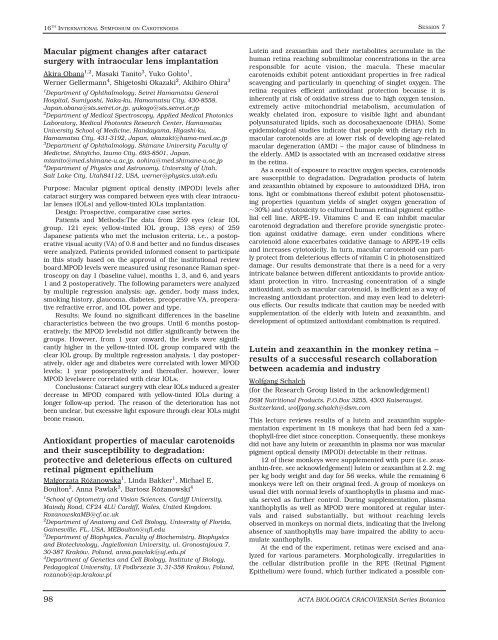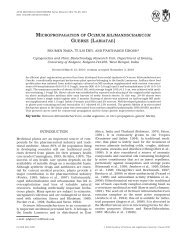ACTA BIOLOGICA CRACOVIENSIA
ACTA BIOLOGICA CRACOVIENSIA
ACTA BIOLOGICA CRACOVIENSIA
Create successful ePaper yourself
Turn your PDF publications into a flip-book with our unique Google optimized e-Paper software.
16 TH INTERNATIONAL SYMPOSIUM ON CAROTENOIDS<br />
Macular pigment changes after cataract<br />
surgery with intraocular lens implantation<br />
Akira Obana1,2 , Masaki Tanito3 , Yuko Gohto1 ,<br />
Werner Gellermann 4 , Shigetoshi Okazaki2 , Akihiro Ohira3 1 Department of Ophthalmology, Seirei Hamamatsu General<br />
Hospital, Sumiyoshi, Naka-ku, Hamamatsu City, 430-8558,<br />
Japan.obana@sis.seirei.or.jp, yukogo@sis.seirei.or.jp<br />
2 Department of Medical Spectroscopy, Applied Medical Photonics<br />
Laboratory, Medical Photonics Research Center, Hamamatsu<br />
University School of Medicine, Handayama, Higashi-ku,<br />
Hamamatsu City, 431-3192, Japan, okazaki@hama-med.ac.jp<br />
3 Department of Ophthalmology, Shimane University Faculty of<br />
Medicine, Shiojicho, Izumo City, 693-8501, Japan,<br />
mtanito@med.shimane-u.ac.jp, aohira@med.shimane-u.ac.jp<br />
4 Department of Physics and Astronomy, University of Utah,<br />
Salt Lake City, Utah84112, USA, werner@physics.utah.edu<br />
Purpose: Macular pigment optical density (MPOD) levels after<br />
cataract surgery was compared between eyes with clear intraocular<br />
lenses (IOLs) and yellow-tinted IOLs implantation.<br />
Design: Prospective, comparative case series.<br />
Patients and Methods:The data from 259 eyes (clear IOL<br />
group, 121 eyes; yellow-tinted IOL group, 138 eyes) of 259<br />
Japanese patients who met the inclusion criteria, i.e., a postoperative<br />
visual acuity (VA) of 0.8 and better and no fundus diseases<br />
were analyzed. Patients provided informed consent to participate<br />
in this study based on the approval of the institutional review<br />
board.MPOD levels were measured using resonance Raman spectroscopy<br />
on day 1 (baseline value), months 1, 3, and 6, and years<br />
1 and 2 postoperatively. The following parameters were analyzed<br />
by multiple regression analysis: age, gender, body mass index,<br />
smoking history, glaucoma, diabetes, preoperative VA, preoperative<br />
refractive error, and IOL power and type.<br />
Results: We found no significant differences in the baseline<br />
characteristics between the two groups. Until 6 months postoperatively,<br />
the MPOD levelsdid not differ significantly between the<br />
groups. However, from 1 year onward, the levels were significantly<br />
higher in the yellow-tinted IOL group compared with the<br />
clear IOL group. By multiple regression analysis, 1 day postoperatively,<br />
older age and diabetes were correlated with lower MPOD<br />
levels; 1 year postoperatively and thereafter, however, lower<br />
MPOD levelswere correlated with clear IOLs.<br />
Conclusions: Cataract surgery with clear IOLs induced a greater<br />
decrease in MPOD compared with yellow-tinted IOLs during a<br />
longer follow-up period. The reason of the deterioration has not<br />
been unclear, but excessive light exposure through clear IOLs might<br />
beone reason.<br />
Antioxidant properties of macular carotenoids<br />
and their susceptibility to degradation:<br />
protective and deleterious effects on cultured<br />
retinal pigment epithelium<br />
Małgorzata Różanowska 1 , Linda Bakker 1 , Michael E.<br />
Boulton 2 , Anna Pawlak 3 , Bartosz Różanowski 4<br />
1 School of Optometry and Vision Sciences, Cardiff University,<br />
Maindy Road, CF24 4LU Cardiff, Wales, United Kingdom,<br />
RozanowskaMB@cf.ac.uk<br />
2 Department of Anatomy and Cell Biology, University of Florida,<br />
Gainesville, FL, USA, MEBoulton@ufl.edu<br />
3 Department of Biophysics, Faculty of Biochemistry, Biophysics<br />
and Biotechnology, Jagiellonian University, ul. Gronostajowa 7,<br />
30-387 Kraków, Poland, anna.pawlak@uj.edu.pl<br />
4 Department of Genetics and Cell Biology, Institute of Biology,<br />
Pedagogical University, Ul Podbrzezie 3, 31-358 Kraków, Poland,<br />
rozanob@ap.krakow.pl<br />
Lutein and zeaxanthin and their metabolites accumulate in the<br />
human retina reaching submilimolar concentrations in the area<br />
responsible for acute vision, the macula. These macular<br />
carotenoids exhibit potent antioxidant properties in free radical<br />
scavenging and particularly in quenching of singlet oxygen. The<br />
retina requires efficient antioxidant protection because it is<br />
inherently at risk of oxidative stress due to high oxygen tension,<br />
extremely active mitochondrial metabolism, accumulation of<br />
weakly chelated iron, exposure to visible light and abundant<br />
polyunsaturated lipids, such as docosahexaenoate (DHA). Some<br />
epidemiological studies indicate that people with dietary rich in<br />
macular carotenoids are at lower risk of developing age-related<br />
macular degeneration (AMD) – the major cause of blindness in<br />
the elderly. AMD is associated with an increased oxidative stress<br />
in the retina.<br />
As a result of exposure to reactive oxygen species, carotenoids<br />
are susceptible to degradation. Degradation products of lutein<br />
and zeaxanthin obtained by exposure to autooxidized DHA, iron<br />
ions, light or combinations thereof exhibit potent photosensitizing<br />
properties (quantum yields of singlet oxygen generation of<br />
~30%) and cytotoxicity to cultured human retinal pigment epithelial<br />
cell line, ARPE-19. Vitamins C and E can inhibit macular<br />
carotenoid degradation and therefore provide synergistic protection<br />
against oxidative damage, even under conditions where<br />
carotenoid alone exacerbates oxidative damage to ARPE-19 cells<br />
and increases cytotoxicity. In turn, macular carotenoid can partly<br />
protect from deleterious effects of vitamin C in photosensitized<br />
damage. Our results demonstrate that there is a need for a very<br />
intricate balance between different antioxidants to provide antioxidant<br />
protection in vitro. Increasing concentration of a single<br />
antioxidant, such as macular carotenoid, is inefficient as a way of<br />
increasing antioxidant protection, and may even lead to deleterious<br />
effects. Our results indicate that caution may be needed with<br />
supplementation of the elderly with lutein and zeaxanthin, and<br />
development of optimized antioxidant combination is required.<br />
Lutein and zeaxanthin in the monkey retina –<br />
results of a successful research collaboration<br />
between academia and industry<br />
Wolfgang Schalch<br />
(for the Research Group listed in the acknowledgement)<br />
DSM Nutritional Products, P.O.Box 3255, 4303 Kaiseraugst,<br />
Switzerland, wolfgang.schalch@dsm.com<br />
SESSION 7<br />
This lecture reviews results of a lutein and zeaxanthin supplementation<br />
experiment in 18 monkeys that had been fed a xanthophyll-free<br />
diet since conception. Consequently, these monkeys<br />
did not have any lutein or zeaxanthin in plasma nor was macular<br />
pigment optical density (MPOD) detectable in their retinas.<br />
12 of these monkeys were supplemented with pure (i.e. zeaxanthin-free,<br />
see acknowledgement) lutein or zeaxanthin at 2.2. mg<br />
per kg body weight and day for 56 weeks, while the remaining 6<br />
monkeys were left on their original feed. A group of monkeys on<br />
usual diet with normal levels of xanthophylls in plasma and macula<br />
served as further control. During supplementation, plasma<br />
xanthophylls as well as MPOD were monitored at regular intervals<br />
and raised substantially, but without reaching levels<br />
observed in monkeys on normal diets, indicating that the livelong<br />
absence of xanthophylls may have impaired the ability to accumulate<br />
xanthophylls.<br />
At the end of the experiment, retinas were excised and analyzed<br />
for various parameters. Morphologically, irregularities in<br />
the cellular distribution profile in the RPE (Retinal Pigment<br />
Epithelium) were found, which further indicated a possible con-<br />
98 <strong>ACTA</strong> <strong>BIOLOGICA</strong> <strong>CRACOVIENSIA</strong> Series Botanica












